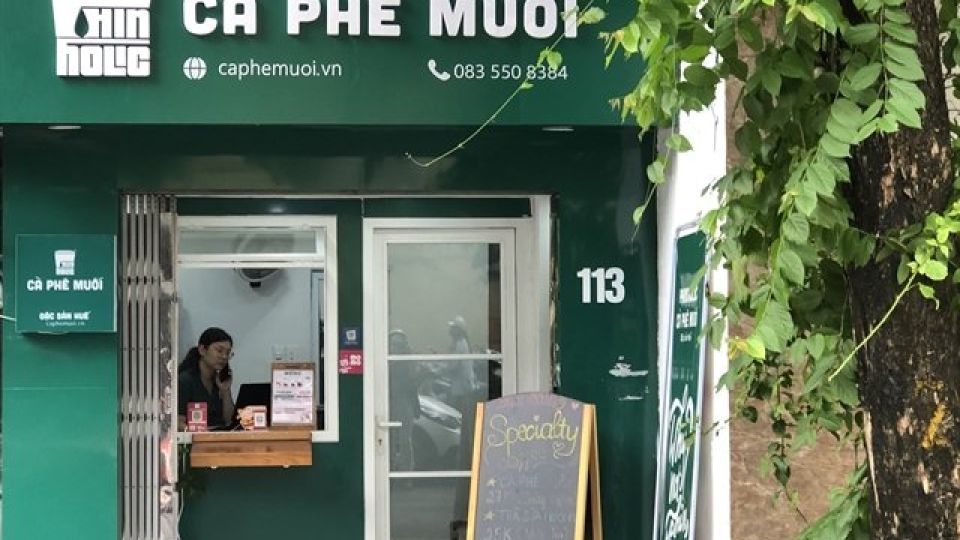September 21, 2023
HANOI – While many have commented on Việt Nam’s unique coffee culture amid a continent renowned for tea, recent innovations have enhanced its appeal.
Even in the heart of the coffee kingdom, the Central Highlands province of Đắk Lắk, one can discover smaller plantations contributing refined flavours to these globally celebrated beverages.
Hà Nội has recently introduced another speciality to its gourmet coffee repertoire: Salt coffee, a treat originating from Huế.
Just over a decade ago, a duo in Huế decided to experiment by infusing their condensed milk coffee with a trending matcha salty whipped cream topping. This inventive blend has since become iconic.
Salt coffee is now a hallmark of Huế, the city of Việt Nam’s last kings, and stands as a testament to its enduring and intricate culinary heritage. This culinary artistry persisted even after the last king abdicated in 1945, transitioning the nation to a republic.
Historically, Huế’s grassroots chefs had a penchant for incorporating salt in their creations. Salt rice, for instance, has been a centrepiece of royal feasts, where an elaborate ten-course meal offers an unforgettable experience for lucky attendees.
Salt rice feast
Cultural experts agree that sampling the Salt Rice Tray in Huế is akin to experiencing a centuries-old culinary heritage. Chefs have turned the most ordinary dishes of common people into a treasure trove.
Tôn nữ thị Hà, a distinguished home chef in Huế, meticulously preserves 36 salt-based recipes in her personal cookbook.
“Huế’s salt marinated dishes may sound simple, yet they represent our philosophy reflecting our ancestors’ new land reclaiming process, their survival in harsh natural circumstances. Many dishes of ordinary people have come into the royal menu as our ancestors grew up on these dishes.”
Salt dishes in Huế are typically grouped into three categories: salted vegetables and nuts, which include the likes of salted sesame, peanuts, apricots, and lemons; salted seafood, featuring items such as salted fish, shrimp, and various rice-field fish; and lastly, salted meats encompassing pork and beef.
Traditionally, salt was used either as a marinade or an ingredient, enhancing the flavour of vegetables and nuts, and encouraging moderate consumption. As royal feasts became less frequent over the years, the practice of enjoying these salt dishes, limited to a few ingredients, became confined to individual households.
In the present day, one can pre-book a grand salt feast at certain restaurants, but it’s typically reserved for special events. A group of Huế’s signature chefs is currently collating documentation, aiming to submit it to UNESCO for recognition and protection as a cultural heritage.
Given this deeply ingrained salt culinary tradition in the daily lives of Huế’s inhabitants, the introduction of salt to their coffee culture might have come later, but it seems it was always destined to be.
Salt coffee conquers Hà Nội
Salt Coffee was first made by the owners of Cafe Muối, at 10 Nguyễn Lương Bằng in Huế, a city with a population just shy of half a million.
Following this innovation, many other coffee establishments in Huế began crafting their own versions of the beverage, leading to a bustling market for such a novel creation.
Salt coffee is distinctively prepared using hand-filtered coffee through either a metal or ceramic filter, combined with condensed milk. It is then garnished with salty whipped cream and a sprinkle of cinnamon powder.
A decade ago, inspired by the emerging trend of salt coffee in Huế, a husband-wife duo established a business which championed province specialities. Nguyễn thị Như Mai, the wife, is the proprietor of Phinholic, a series of ‘coffee-holic’ establishments, alongside The Hut, renowned for its paper straws, The Aroma, a centre dedicated to mixology, and ‘How to Make’, an application guiding users in coffee preparation.
On the other hand, Mai Khắc Khôi, the husband, spearheads the Green Field Coffee company, which specialises in roasting coffee beans and supplying them to various coffee shops across Huế. He also sources coffee grown in the A Lưới District of Thừa Thiên – Huế province.
They opened their first Phinholic cafe in Hà Nội last year.
Cao Huy Miên Nhã, co-owner of the Phinholic shop on Nguyễn Khuyến Street tells Việt Nam News: “We sell between 30-40 cups a day.”
In a city like Hà Nội, home to 8 million residents and a myriad of coffee shops, the numbers might seem insignificant. Yet, when considering that their coffee beans are sourced exclusively from A Lưới district in Huế, and that the caffeine content is calibrated to ensure it’s safe for consumers, this unique offering is bound to carve out its niche audience.
Detractors might argue that the Vietnamese already incorporate a substantial amount of salt in their daily diets. Health experts suggest a reduction in daily salt intake. Such warnings can be beneficial for those keen on maintaining their caffeine habits.
Phinholic makers already had that in mind, “Each portion comprises 160ml of coffee,” Miên Nhã told Việt Nam News adding, ” “Our coffee brewers have taken barista certificates issued by the Specialty Coffee Association.”
Nowadays in Hà Nội, you can stumble upon salt coffee in nearly every pavement cafe, sitting alongside other beloved beverages from various parts of Việt Nam. Alongside the fresh coconut juice from Bến Tre Province or the delightful lemon/kumquat tea, always remember that salt coffee traces its origins back to Huế. — VNS


